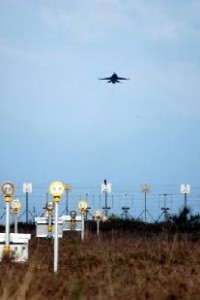Nuclear weapons can be eliminated: Chapter 4, Part 1
Jul. 12, 2009
Chapter 4: NATO's Cold War relics
Part 1: Nuclear sharing
by Yumi Kanazaki, Staff Writer
U.S. nuclear weapons deployed in non-nuclear nations
Twenty years after the fall of the Berlin Wall, the symbol of the conflict between East and West, the purpose of Europe’s nuclear weapons is becoming less clear. Yet the United Kingdom and France continue to possess their own nuclear weapons, and U.S. tactical nuclear weapons are still deployed in the member nations of the North Atlantic Treaty Organization (NATO). Why can’t these relics of the Cold War be removed? The Chugoku Shimbun looked at this situation in the NATO nations.
The air base at Kleine Brogel, a village in the city of Peer, is a two-and-a-half-hour drive from NATO headquarters in Brussels and 7 kilometers from the border with the Netherlands. The flags of Belgium and the U.S. fly at the main gate.
As I gazed at the runway beyond the fence, which was surrounded by tranquil pastures and fields, a military aircraft suddenly turned in the sky above. I shuddered at its roar. It was a U.S.-designed F-16 fighter plane.
Roel Stynen, 28, a member of Peace Action, a group that monitors the base, said, “The squadron based here is prepared to drop American nuclear bombs, and they are training for it. We oppose that nuclear sharing.”
Under nuclear sharing, U.S. military forces are stationed at air bases in NATO nations and maintain the nuclear weapons there. If war should break out, these nuclear weapons will be transferred to the nation in which they are deployed and may be used by that nation in battle. Thus it is a system by which nuclear attack is delegated.
There are believed to be between 10 and 20 American B61 nuclear bombs, which can be deployed on fighter aircraft, at the air base in Kleine Brogel. Stynen said this sharing is in violation of the ban on the transfer of nuclear weapons included in the Nuclear Non-proliferation Treaty.
The number of nuclear weapons has declined considerably since its peak, and their possession by non-nuclear nations is a violation of the NPT. So why are nuclear weapons necessary in this post-Cold War era?
Ludwig Vandenhove, 49, chairman of the Belgian House Defense Committee, offered this explanation. “It is a sort of taboo for people to talk about the nuclear weapons in their countries because NATO has not disclosed their location.” In January 2008, Belgian Defense Minister Pieter de Crem inadvertently acknowledged the existence of nuclear weapons after making an inspection of the base. This news ignited a furor and he later retracted the comment. Apparently, it is not easy to criticize the former symbol of the military alliance in NATO’s hometown.
On the other hand, in April 2005 the Belgian Senate passed a resolution calling for the progressive removal of the tactical nuclear weapons.
Senator Patrik Vankrunkelsven, 51, said, “I wanted to tie it into the debate on nuclear sharing.” As a former mayor of Laakdal, he is actively involved in Mayors for Peace, chaired by Hiroshima Mayor Tadatoshi Akiba. In January he worked for the adoption of a resolution in the Belgian Senate calling for the promotion of nuclear disarmament, including support for the Hiroshima-Nagasaki Protocol, which aims for the abolition of nuclear weapons by 2020.
Progress is slowly being made.
North Atlantic Treaty Organization (NATO)
The North Atlantic Treaty Organization is a military alliance that was formed by the U.S., Canada, and 10 European nations in April 1949 to counter the threat posed by the Soviet Union and the Eastern European nations of the Warsaw Pact.
Following the end of the Cold War, a new meaning for NATO’s existence was sought. NATO forces have been deployed in areas outside the region, including the former Yugoslavia during the regional conflict there and in Afghanistan as part of the war on terror. NATO has expanded eastward and now has 28 member nations. The U.S. plan to deploy its missile defense system in Eastern Europe is one factor behind tensions with Russia.
(Originally published June 13, 2009)
To comment on this article, please click the link below. Comments will be moderated and posted in a timely fashion. Comments may also appear in the Chugoku Shimbun newspaper.








